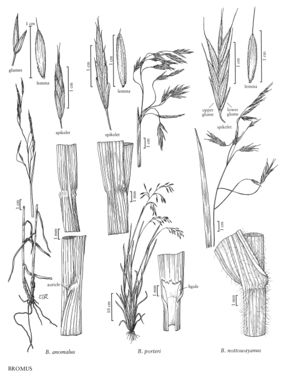Bromus nottowayanus
Plants perennial; not rhizomatous. Culms (60)70-140 cm, erect or spreading; nodes 5-9, pubescent or glabrous, often concealed by the sheaths; internodes usually glabrous. Sheaths usually retrorsely pilose, some¬times glabrous, with a dense line of hairs at the collar, lower sheaths often sericeous; auricles absent; ligules 0.4-1 mm, often hairy, truncate, erose, ciliolate; blades 15-30 cm long, 5-12 mm wide, often shiny yellow-green, flat, abaxial surfaces pilose, adaxial surfaces glabrous or pilose over the veins. Panicles 9-25 cm, open, nodding; branches ascending or spreading, often recurved. Spikelets 18-30 mm, elliptic to lanceolate, terete to moderately laterally compressed, often purplish, with 6-12 florets. Glumes usually pubescent; lower glumes 5.5-8 mm, 1(3)-veined; upper glumes 7-10 mm, 5-veined, often mucronate; lemmas 8-13 mm, elliptic to lanceolate, rounded over the midvein, usually uniformly densely hairy, or the backs less densely so, apices acute to obtuse, entire; awns 5-8 mm, straight, arising less than 1.5 mm below the lemma apices; anthers 2.8-3.5(5) mm. 2n = 14.
Distribution
Kans., Tenn., Md., Mich., Mo., N.C., Ga., Iowa, Ala., Ark., Ind., N.J., Okla., Tex., N.Y., Va., Ill., Ont., Ky., Ohio
Discussion
Bromus nottowayanus is native to the east-central and eastern United States from Iowa to New York, south to Oklahoma, northern Alabama, and Virginia. It grows in damp, shaded woods, often in ravines and along streams.
Selected References
None.
